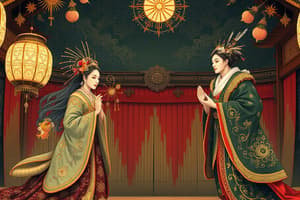Podcast
Questions and Answers
What was the main concern of Renaissance humanism?
What was the main concern of Renaissance humanism?
- Humans and their everyday life (correct)
- The prosperity of the kingdoms
- The discovery of new lands
- The elegance of art and architecture
What was a major innovation in Italian Renaissance theatre?
What was a major innovation in Italian Renaissance theatre?
- The use of masks in performances
- The development of dramatic criticism with Neoclassical rules (correct)
- The creation of the proscenium arch
- The invention of the Spotlight
What style of Kabuki acting is characterized as athletic and exaggerated?
What style of Kabuki acting is characterized as athletic and exaggerated?
- Wagoto
- Dance play
- Sewa-mono
- Aragoto (correct)
What invention during the Renaissance had a significant impact on the spread of knowledge?
What invention during the Renaissance had a significant impact on the spread of knowledge?
What was the primary motivation for merchants to become patrons of the arts during the Renaissance?
What was the primary motivation for merchants to become patrons of the arts during the Renaissance?
What is the name of the Kabuki play that features a subscription list and explores the conflict between giri and ninjo?
What is the name of the Kabuki play that features a subscription list and explores the conflict between giri and ninjo?
What style of Kabuki acting is characterized as refined and realistic, often used in plays dealing with everyday life?
What style of Kabuki acting is characterized as refined and realistic, often used in plays dealing with everyday life?
What art technique developed during the Renaissance allowed for more realistic and three-dimensional representations?
What art technique developed during the Renaissance allowed for more realistic and three-dimensional representations?
What is a significant innovation in Italian theatre, particularly in scene design?
What is a significant innovation in Italian theatre, particularly in scene design?
What style of theatre emerged from the Italian Renaissance, characterized by stock characters and improvisation?
What style of theatre emerged from the Italian Renaissance, characterized by stock characters and improvisation?
What was the purpose of Intermezzi in Italian theatre?
What was the purpose of Intermezzi in Italian theatre?
What is a key principle of Neoclassical Rules in Italian dramatic criticism?
What is a key principle of Neoclassical Rules in Italian dramatic criticism?
What was the influence of Greek and Roman drama on Italian dramatic criticism?
What was the influence of Greek and Roman drama on Italian dramatic criticism?
What was the architectural innovation in Italian theatre?
What was the architectural innovation in Italian theatre?
When did the English Renaissance Theatre begin?
When did the English Renaissance Theatre begin?
What was the term used to describe the theatre during Elizabeth's reign?
What was the term used to describe the theatre during Elizabeth's reign?
Who was the most influential of the University Wits?
Who was the most influential of the University Wits?
What was the name of Christopher Marlowe's most influential drama?
What was the name of Christopher Marlowe's most influential drama?
What was the trend carried to London's Inns of Court?
What was the trend carried to London's Inns of Court?
When did the English Renaissance Theatre end?
When did the English Renaissance Theatre end?
Flashcards are hidden until you start studying
Study Notes
Japanese Theatre
- Enya Hangan Takasada changed his name to Asano Takuminokami Naganori
- Kohno Moronoh changed his name to Kira Kozukenosuke
- Oboshi yuranosuke changed his name to Oishi Kuran
- Sewa-mono is a type of domestic play that deals with the lives of ordinary citizens of the Edo era
- Dance plays often feature ghosts, courtesans, and other exotic creatures
- Aragoto is a rough style of acting that is athletic, exaggerated, and masculine, developed by Ichikawa Danjuro in the late 17th century
- Examples of Aragoto include Kanjincho and Matsubame-mono
- Wagoto is a gentle style of acting used mainly by actors playing romantic male leads, developed by Sakata Tojuro I in the late 17th century in Osaka
Renaissance Italy
- The Renaissance was a revived interest in humanist ideal of the classical world, focusing on humans and early life
- Merchants became patrons of arts to display their wealth
- Great inventions and discoveries included perspective, printing, and the telescope
- Theatre in Italian Renaissance had major innovations in three areas of theatre arts
Theatre in English Renaissance
- English Renaissance Theatre had main innovations in three areas of theatre arts
- The main stage of English Renaissance Theatre was Elizabethan Theatre
- The Tudor line founded by Henry VII included Henry VIII, Edward VI, Mary I, and Elizabeth I
- Early Renaissance developments included School Drama Trend, University Wits, and Christopher Marlowe
- Marlowe's most influential dram was Doctor Faustus, which employed elements of Morality Plays and Italian Intermezzi
- Professional Acting Troupes, commedia dell'arte, and scene design innovations like painted-perspective scenery and groove system of scene changes were key features of the era
Italian Dramatic Criticism
- Italian critics formulated Neoclassical Rules that dominated dramatic theory in Europe for nearly 200 years
- The rules included unity of time, place, action, decorum, verisimilitude, genre, and five-act rules
- Aristotle's Poetics and Horace's Art of Poetry greatly deviated from these rules
From Intermezzi to Opera
- Intermezzi were elaborate complements that suggested parallels between mythological figures and the person in whose honor the festival was being given
- Intermezzi were played between the acts of regular plays and became a primary medium for popularizing perspective scenery and the picture-frame stage
- Intermezzi eventually developed into Opera
Studying That Suits You
Use AI to generate personalized quizzes and flashcards to suit your learning preferences.




